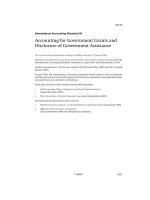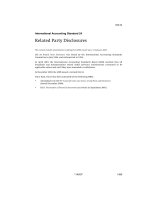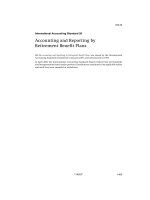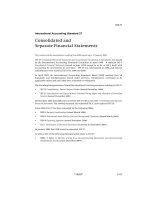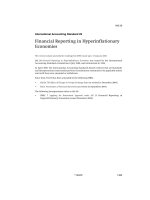chuẩn mực kế toán quốc tế ias 2 costs of purchase
Bạn đang xem bản rút gọn của tài liệu. Xem và tải ngay bản đầy đủ của tài liệu tại đây (101 KB, 7 trang )
IAS 2
Example 1– costs of purchase
A retailer imported goods at a cost of CU130 , including CU20 non-refundable import duties and
CU10 refundable purchase taxes. The risks and rewards of ownership of the imported goods
were transferred to the retailer upon collection of the goods from the harbour warehouse. The
retailer was required to pay for the goods upon collection. The retailer incurred CU5 to
transport the goods to its retail outlet and a further CU2 in delivering the goods to its customer.
Further selling costs of CU3 were incurred in selling the goods.
Example 2 – costs of purchase
A retailer buys a good priced at CU500 per unit. However, the supplier awards the retailer a 20
per cent discount on orders of 100 units or more. The retailer buys 100 units in a single order.
Example 3 – costs of purchase
A retailer buys a good priced at CU500 per unit. However, the supplier awards the retailer a 20
per cent discount on orders of 100 units or more. Furthermore, when the retailer has purchased
1,000 or more units in a calendar year, the supplier awards the retailer a further volume discount
of 10 per cent of the list price. The additional volume discount applies to all units acquired by
the retailer during the calendar year. On 1 January 20X1 the retailer buys 1,000 units from the
supplier in a single order.
Example 4 – costs of purchase
The facts are the same as in example 3 above. However, in this example, on 1 January 20X1 the
entity purchased 800 units from the supplier. Because management considered it unlikely that
the entity would purchase another 200 or more units from the same supplier in 20X1, the entity
initially measured the inventories at CU320,000 (ie 800 units × CU500 each × 80%).
On 24 December 20X1 the entity purchased a further 200 units from the supplier.
On 31 December 20X1 150 units acquired from the supplier were unsold (ie in inventories) by
the retailer.
Example 5 – costs of purchase
On 1 November 20X1 a retailer buys 90 units of a good from a supplier for CU500 per unit on
60 days’ interest-free credit (normal credit terms). To encourage early settlement the supplier
awarded the retailer a 10 per cent early settlement discount for settling within 30 days of buying
the goods.
On 30 November 20X1 the retailer paid CU40,500 to settle the amount owing for the 90 units
purchased from the supplier.
Example 6 – costs of purchase
An entity acquired an item of inventory for CU2,000,000 on two-year interest-free credit. The
identical item is available in the same market for CU1,654,000 if payment is made within 30
days of the date of purchase (ie normal credit terms).
Example 7 – costs of purchase
An entity acquired an item of inventory for CU2,000,000 on two-year interest-free credit. An
appropriate discount rate is 10 per cent per year.
1
Example 8 – Allocation of production overheads
An entity incurred fixed production overheads of CU900,000 during a one-month period in
which it manufactured 250,000 units of production. When operating at normal capacity the
entity manufactures 250,000 units of production per month.
Example 9 – Allocation of production overheads
The facts are the same as in example 8. However, in this example, the entity manufactured
200,000 units of production during the month.
.
Example 10 – Allocation of production overheads
The facts are the same as in example 8. However, in this example, the entity manufactured
300,000 units during the month. This level of production is abnormally high.
Example 11- Joint products and by-products
An entity manufactures a chemical ‘A’ for use in the agriculture industry. The production
process requires a mixture of base chemicals followed by a maturation process, and from which,
a product ‘A’ and a by-product ‘C’ are produced.
The total costs of a production run (ie including direct costs and the allocation of overheads) is
CU100,000.
Each production run produces:
• 5,000 litres of product A, sales value = CU250,000
• 1,000 litres of (by-product) C, sales value = CU2,000
Example 12- Joint products and by-products
The facts are the same as in example 11. However, in this example, instead of the by-product
there is another joint product ‘B’ resulting from the maturation process.
Furthermore, the total costs (ie including direct costs and the allocation of overheads) of a
production run are CU300,000.
Each production run produces:
• 5,000 litres of product A, sales value = CU250,000
• 4,000 litres of product B, sales value = CU400,000
Example 13- Joint products and by-products
The facts are the same as in example 11. However, in this example, the maturation process
produces products ‘A’ and ‘B’ and by-product ‘C’. The total cost (ie including direct costs and
the allocation of overheads) of a production run is CU300,000.
The entity accounts for the by-product by deducting its selling price from the cost of the
main products. In this example, the costs to complete and sell the by-product are negligible and
have been ignored.
Each production run produces:
• 5,000 litres of product A, sales value = CU250,000
2
• 4,000 litres of product B, sales value = CU400,000
• 1,000 litres of (by-product) C, sales value = CU2,000
Case Study 1
Facts
Brilliant Trading Inc. purchases motorcycles from various countries and exports them to Europe.
Bril-liant Trading has incurred these expenses during 2005:
(a) Cost of purchases (based on vendors’ invoices)
(b) Trade discounts on purchases
(c) Import duties
(d) Freight and insurance on purchases
(e) Other handling costs relating to imports
(f) Salaries of accounting department
(g) Brokerage commission payable to indenting agents for arranging imports
(h) Sales commission payable to sales agents
(i) After-sales warranty costs
Required
Brilliant Trading Inc. is seeking your advice on which costs are permitted under IAS 2 to be
included in cost of inventory.
Case Study 2
First-in, First-out (FIFO) Method
Facts
XYZ Inc. is a newly established international trading company. It commenced its operation in
2005. XYZ imports goods from China and sells in the local market. It uses the FIFO method to
value its inventory. Listed next are the purchases and sales made by the entity during the year
2005:
Purchases
January 2005 10,000 units @ $ 25 each
March 2005 15,000 units @ $ 30 each
September 2005 20,000 units @ $ 35 each
Sales
May 2005 15,000 units
November 2005 20,000 units
Required
Based on the FIFO cost flow assumption, compute the value of inventory at May 31, 2005,
September 30, 2005, and December 31, 2005.
Case Study 3
Weighted-Average Cost Method
Facts
3
Vigilant LLC, a newly incorporated company, uses the latest version of a software package
(EXODUS) to cost and value its inventory. The software uses the weighted-average cost method
to value inventory. The following are the purchases and sales made by Vigilant LLC during 2006
(as a newly set up company, Vigilant LLC has no beginning inventory):
Purchases
January 100 units @ $250 per unit
March 150 units @ $300 per unit
September 200 units @ $350 per unit
Sales
March 150 units
December 170 units
Required
Vigilant LLC has approached you to compute the value of its inventory and the cost per unit of
the
inventory at March 31, 2006, September 30, 2006, and December 31, 2006, under the weighted-
average cost method.
Case Study 4
Facts
Moonstruck Enterprises Inc. is a retailer of Italian furniture and has five major product lines:
sofas,
dining tables, beds, closets, and lounge chairs. At December 31, 200X, quantity on hand, cost per
unit,
and net realizable value (NRV) per unit of the product lines are as follows:
Product line Quantity Cost NRV
on hand per unit ($) per unit ($)
Sofas 100 1,000 1,020
Dining tables 200 500 450
Beds 300 1,500 1,600
Closets 400 750 770
Lounge chairs 500 250 200
Required
Compute the valuation of the inventory of Moonstruck Enterprises at December 31, 200X, under
IAS 2 using the “lower of cost and NRV” principle.
Case study 5
SME A began operations in 20X1. In 20X1 it incurred the following expenditures in
purchasing materials for producing its product:
Purchase price of raw materials = CU30,000
Import duty and other non-refundable purchase taxes = CU8,000
4
Refundable purchase taxes = CU1,000
Freight costs for bringing the goods from the supplier to the factory raw material
storeroom = CU3,000
Costs of unloading the materials into the raw material storeroom = CU20
Packaging = CU2,000
On 31 December 20X1 SME A received CU530 volume rebate from a supplier for
purchasing more than CU15,000 from the supplier during the year.
SME A incurred the following additional costs in the production run:
Salary of the machine workers in the factory = CU5,000
Salary of factory supervisor = CU3,000
Depreciation of the factory building and equipment used for production process =
CU600
Consumables used in the production process = CU200
Depreciation of vehicle used to transport the goods from the raw materials storeroom
to the machine floor = CU400
Factory electricity usage charges = CU300
Factory rental = CU1,000
Depreciation and maintenance of the entity’s vehicle used by the factory supervisor
(50 per cent for official use and 50 per cent for personal use) = CU200. Private use of the
vehicle is an employee benefit.
During 20X1 SME A incurred the following administration expenses:
Depreciation of the administration building = CU500
Depreciation and maintenance of vehicles used by the administrative staff = CU150
Salaries of the administration personnel = CU3,050
Of the administration expenses 20 per cent are attributable to administering the factory.
The rest of the administration expenses are attributable, in equal proportion, to the sales
and other non-production operations (eg financing, tax and corporate secretarial
functions).
In 20X1 SME A incurred the following selling expenses:
Advertising costs = CU300
Depreciation and maintenance of vehicles used by the sales staff = CU100
Salary of the administration personnel = CU6,000
Prepare the accounting entries to record the inventory cost in the accounting records of
SME A.
Case study 6
5
SME B, manufactures three products—products A, B and C. The three products are
produced simultaneously in a single production process. However, products A and B
require further processing after the joint process before being ready for sale:
Costs incurred within the joint production process (CU):
Raw materials :120,000
Consumable stores :10,000
Direct labour costs :50,000
Variable production overhead :45,000
: 225,000
Fixed production overheads allocated on the basis of use of services: 55,000
Costs incurred after the joint production process:
product A 10,000
product B 12,000
Units produced
product A 400
product B 400
product C 350
Total sales value of all units produced
product A 120,000
product B 140,000
product C 70,000
Determine the cost of each unit of products A, B and C.
MULTIPLE-CHOICE QUESTIONS
1. Inventory should be stated at
(a) Lower of cost and fair value.
(b) Lower of cost and net realizable value.
(c) Lower of cost and nominal value.
(d) Lower of cost and net selling price.
2. Which of the following costs of conversion can-not be included in cost of inventory?
(a) Cost of direct labor.
(b) Factory rent and utilities.
(c) Salaries of sales staff (sales department shares the building with factory supervisor).
(d) Factory overheads based on normal ca-pacity.
3. Inventories are assets
(a) Held for sale in the ordinary course of business.
(b) In the process of production for such sale.
6
(c) In the form of materials or supplies to be consumed in the production process or the
rendering of services.
(d) Choices a, b, and c.
4. The cost of inventory should not include
(a) Purchase price.
(b) Import duties and other taxes.
(c) Abnormal amounts of wasted materials.
(d) Administrative overhead.
(e) Fixed and variable production overhead.
(f) Selling costs.
(g) Choices c, d, and f.
5. ABC LLC manufactures and sells paper enve-lopes. The stock of envelopes was included in
the closing inventory as of December 31, 2005, at a cost of $50 each per pack. During the final
audit, the auditors noted that the subsequent sale price for the inventory at January 15, 2006,
was $40 each per pack. Furthermore, inquiry reveals that during the physical stock take, a water
leakage has created damages to the paper and the glue. Accordingly, in the following week,
ABC LLC spent a total of $15 per pack for repairing and reapplying glue to the envelopes. The
net realizable value and inventory write-down (loss) amount to
(a) $40 and $10 respectively.
(b) $45 and $10 respectively.
(c) $25 and $25 respectively.
(d) $35 and $25 respectively.
(e) $30 and $15 respectively.
6. The definition of "inventories" given by international standard IAS2 states that items qualify
as inventories only if they are assets held for sale in the ordinary course of business or assets in
the process of production for such sale. True or False?
a. True
b. False
7. Which of the following items cannot be included in the cost of inventories?
a. Irrecoverable import duties payable on the acquisition of inventories
b. Fixed production overheads
c. The cost of abnormal wastage of materials and labour
d. Variable production overheads
8. The FIFO cost formula assumes that:
a. The inventory items which are sold or consumed are those acquired most recently
b. The inventory items which are sold or consumed are those acquired longest ago
c. The inventory items which are sold or consumed are a mixture of those acquired in the last 12
months
d. Newer inventory items are sold or consumed before older inventory items
9. The net realisable value of inventories is defined by IAS2 as:
a. Selling price
b. Cost price
c. Selling price less costs of completion
d. Selling price less costs of completion and selling costs
7



